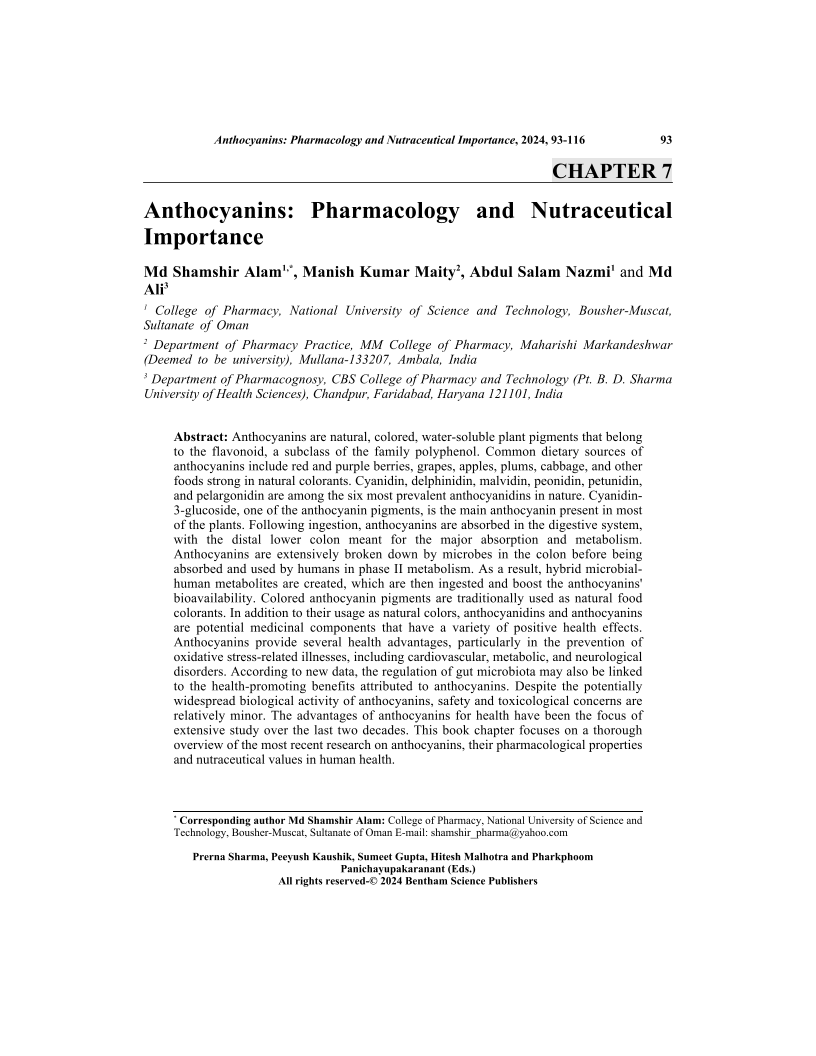Anthocyanins: Pharmacology and Nutraceutical Importance

- Authors: Md Shamshir Alam1, Manish Kumar Maity2, Abdul Salam Nazmi3, Md Ali4
-
View Affiliations Hide Affiliations1 College of Pharmacy, National University of Science and Technology, Bousher Muscat, Sultanate of Oman 2 Department of Pharmacy Practice, MM College of Pharmacy, Maharishi Markandeshwar (Deemed to be university), Mullana-133207, Ambala, India 3 College of Pharmacy, National University of Science and Technology, Bousher-Muscat, Sultanate of Oman 4 Department of Pharmacognosy, CBS College of Pharmacy and Technology (Pt. B. D. Sharma University of Health Sciences), Chandpur, Faridabad, Haryana 121101, India
- Source: Anthocyanins: Pharmacology and Nutraceutical Importance , pp 93-116
- Publication Date: November 2024
- Language: English
Anthocyanins: Pharmacology and Nutraceutical Importance, Page 1 of 1
< Previous page | Next page > /docserver/preview/fulltext/9789815223880/chapter-7-1.gif
Anthocyanins are natural, colored, water-soluble plant pigments that belong to the flavonoid, a subclass of the family polyphenol. Common dietary sources of anthocyanins include red and purple berries, grapes, apples, plums, cabbage, and other foods strong in natural colorants. Cyanidin, delphinidin, malvidin, peonidin, petunidin, and pelargonidin are among the six most prevalent anthocyanidins in nature. Cyanidin3-glucoside, one of the anthocyanin pigments, is the main anthocyanin present in most of the plants. Following ingestion, anthocyanins are absorbed in the digestive system, with the distal lower colon meant for the major absorption and metabolism. Anthocyanins are extensively broken down by microbes in the colon before being absorbed and used by humans in phase II metabolism. As a result, hybrid microbialhuman metabolites are created, which are then ingested and boost the anthocyanins' bioavailability. Colored anthocyanin pigments are traditionally used as natural food colorants. In addition to their usage as natural colors, anthocyanidins and anthocyanins are potential medicinal components that have a variety of positive health effects. Anthocyanins provide several health advantages, particularly in the prevention of oxidative stress-related illnesses, including cardiovascular, metabolic, and neurological disorders. According to new data, the regulation of gut microbiota may also be linked to the health-promoting benefits attributed to anthocyanins. Despite the potentially widespread biological activity of anthocyanins, safety and toxicological concerns are relatively minor. The advantages of anthocyanins for health have been the focus of extensive study over the last two decades. This book chapter focuses on a thorough overview of the most recent research on anthocyanins, their pharmacological properties and nutraceutical values in human health.
-
From This Site
/content/books/9789815223880.chapter-7dcterms_subject,pub_keyword-contentType:Journal -contentType:Figure -contentType:Table -contentType:SupplementaryData105

